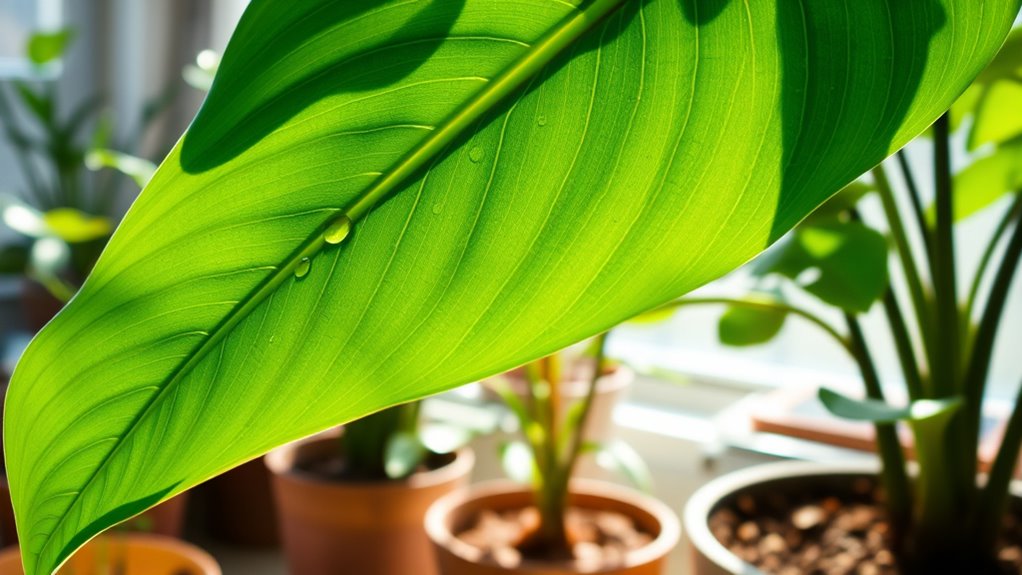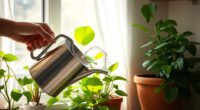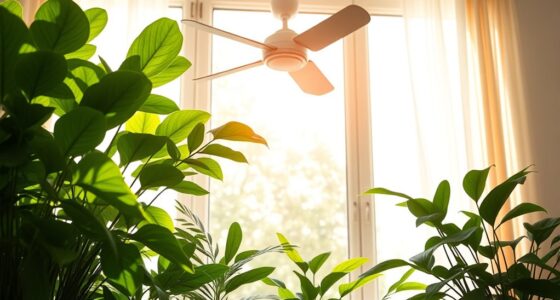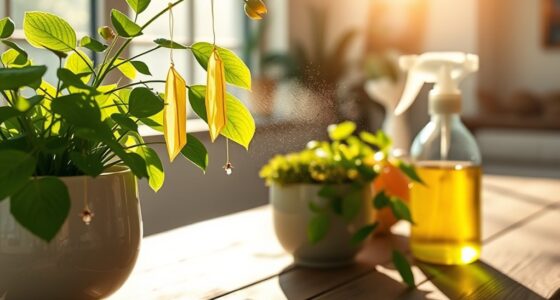To ensure your indoor plants thrive, check their specific watering needs based on their type. Tropical plants may need watering every few days, while succulents can go longer. Adjust your schedule for seasonal changes; increase watering in spring and summer, while reducing it in fall and winter. Monitor humidity levels, as they can impact how often you water. If you want to discover more tips for keeping your plants healthy, keep exploring!
Key Takeaways
- Water tropical plants more frequently, while succulents and snake plants require less frequent watering due to their drought tolerance.
- Adjust watering frequency seasonally: increase in spring and summer, decrease in fall and winter based on growth patterns.
- Monitor humidity levels; most indoor plants thrive in 40-60% humidity, influencing their watering needs.
- Check soil moisture by touch; overwatering can lead to root rot while underwatering causes wilting.
- Use pots with drainage holes and well-draining soil to prevent waterlogged conditions and promote healthy root growth.
Understanding Plant Types and Their Needs
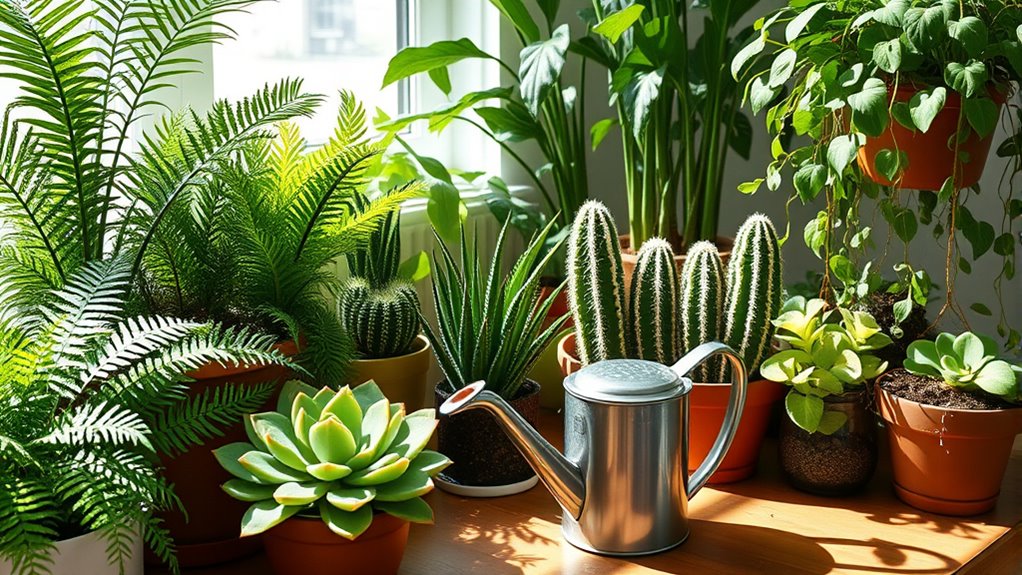
When you start caring for indoor plants, understanding their specific needs is crucial for their health and longevity. Tropical plants, for instance, require more frequent watering than succulents, which thrive on minimal moisture. Ferns love consistently moist environments, while peace lilies give you a clear signal by wilting when they need water, though they can also wilt from overwatering. Understanding plant type is essential to ensure proper watering practices for each species. Additionally, factors like environmental factors such as temperature and humidity can significantly impact how often you should water your plants. For example, plants with high color accuracy in their foliage may need more specific watering routines to maintain their vibrant appearance. It’s important to consider that routine health checks can help identify any watering issues early on.
Snake plants are quite forgiving and generally need less frequent watering. Your choice of pot also plays a role; smaller pots dry out faster than larger ones.
Seasonal Watering Adjustments

As the seasons change, so should your watering routine for indoor plants.
In spring, increase your watering frequency as plants actively grow. Aim to water when the top inch of soil feels dry, using room-temperature water to avoid shocking the roots. During this time, consider applying a water-soluble fertilizer monthly. Understanding seasonal needs is essential to prevent plant stress and ensure healthy growth. Additionally, long-term financial planning can help you invest in quality plant care products. Many indoor plants thrive in well-drained soil, which is crucial for preventing overwatering. Consistent moisture is key for certain plants, similar to how chia seeds thrive when properly watered.
In summer, you might need to water every 3-5 days due to higher evaporation rates.
As temperatures drop in fall, reduce watering to match spring’s frequency, and in winter, water every 7-10 days.
Always monitor soil moisture closely—if the soil feels damp, hold off on watering. Adjust your routine based on your plant’s activity level to keep them healthy year-round.
The Role of Light Exposure

Light exposure plays a crucial role in determining how often you should water your indoor plants. If your plants receive bright light, they’ll need more frequent watering since they use more water for photosynthesis and growth. On the other hand, plants in low-light conditions don’t require as much water, as their growth rate slows down. Different plants have varying light preferences; those classified under low, medium, or high light will each have unique watering schedules. Additionally, understanding the importance of light helps you tailor your watering routine to meet your plants’ needs. Mindful purchasing of plants suited to your light conditions can further enhance your indoor gardening success. It’s also beneficial to consider crochet styles for locs when selecting plants that can thrive in specific light conditions, as some may complement your indoor aesthetic while requiring similar care. Pay attention to window placement—eastern windows often provide optimal light for most plants. Incorporating self-watering features in your plant care routine can also help maintain consistent moisture levels. Regularly check soil moisture to adjust your watering based on light exposure, ensuring your plants thrive without the risk of overwatering or underwatering.
Impact of Humidity Levels

Humidity levels significantly influence how often you should water your indoor plants. Most indoor plants thrive in 40-60% humidity, while tropical varieties prefer a higher range of 80-90%. In winter, reduced humidity from heating often means you’ll need to water less frequently, whereas summer’s heat requires more frequent watering. If your plants are in dry areas or near direct sunlight, they’ll likely need extra hydration. Keep in mind that succulents and cacti need less water due to their adaptation to dry conditions. Use a hygrometer to monitor humidity and adjust your watering schedule accordingly. Seasonal changes can also impact your plants’ moisture requirements, so be attentive to their needs throughout the year. Additionally, common health concerns can arise from improper watering, such as root rot or dehydration. It’s important to note that humidity levels can also affect the rate of evaporation from the soil, influencing how quickly your plants need water. Watch for signs of low humidity, like drooping leaves or brown tips, as these indicate your plants may need more moisture. Consistent monitoring of emergency preparedness strategies can help ensure you’re ready to care for your plants during unexpected changes in your environment.
Choosing the Right Pot Size and Material
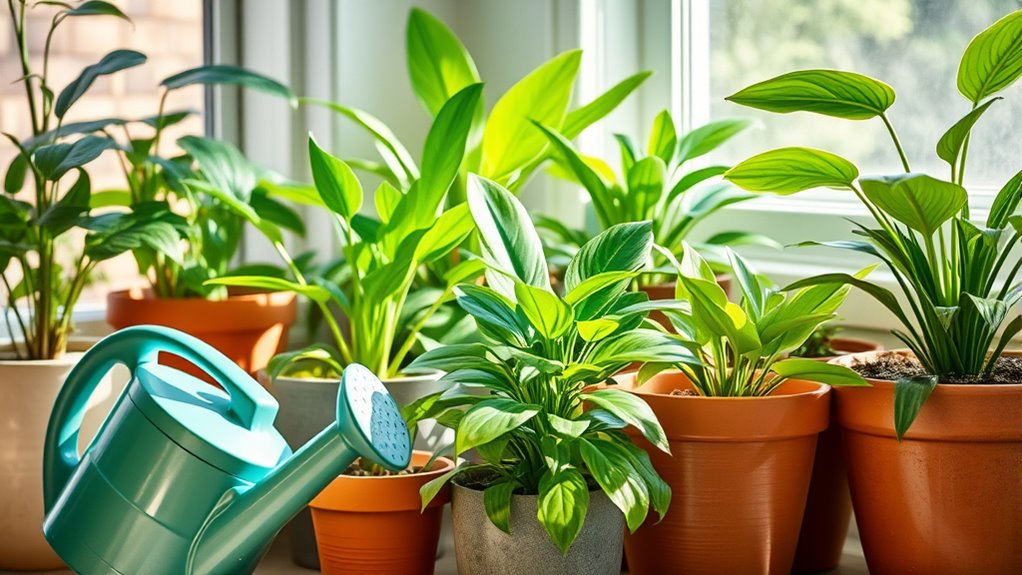
Choosing the right pot size and material is key to your indoor plants’ health and growth. Choose a pot that’s at least one inch wider than your plant’s root system to allow for expansion. Gradually increase pot size to prevent root rot from excess moisture. For fast-growing plants, opt for larger pots sooner, while slower growers can stay in smaller ones. Additionally, consider incorporating energy-efficient designs to create an overall sustainable environment for your plants. The average time to build a tiny house emphasizes the importance of planning for optimal growth conditions.
When it comes to materials, terra cotta and ceramic pots breathe better, helping to manage water retention. Pot size affects soil moisture retention and should be carefully considered to ensure healthy plant growth. Plastic pots are lighter but may not drain as effectively. Consider your plant’s root depth and growth type when choosing shape and size, ensuring a balanced appearance and optimal conditions for your plant’s thriving. Moreover, local building codes can provide insight into creating a healthy indoor space that supports your plants’ needs.
Effective Watering Techniques
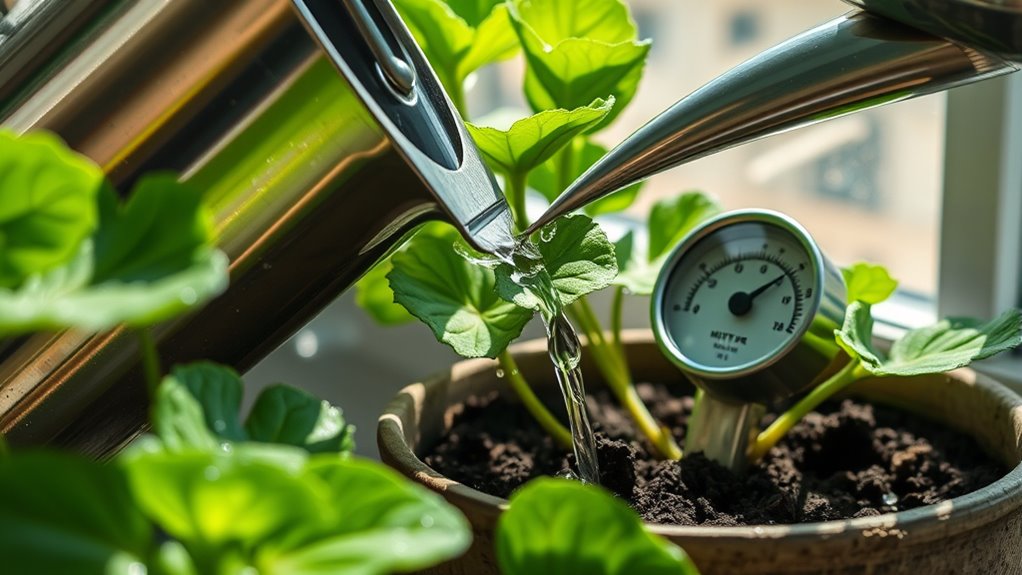
When you want your indoor plants to thrive, mastering effective watering techniques is essential. Start with top watering, allowing excess water to drain out, which is ideal for most plants. Deep watering is crucial too; soak the soil until water flows from the drainage holes, promoting healthy root growth. Always check soil moisture by touch to avoid overwatering, as sitting water can lead to root rot. Use a watering can with a long spout for precision and avoid shocking roots by using room temperature water. Additionally, advance directives can guide plant care decisions if you need assistance while tending to your plants. Astrological compatibility may also influence your choice of plants, as certain plants may resonate better with your zodiac sign. Furthermore, understanding investment strategies can help you allocate resources for purchasing more exotic plant varieties. Adjust your watering routine based on seasonal changes—plants need more in spring and summer, but less in fall and winter. Furthermore, consider each plant’s specific water requirements to ensure they receive the right amount of moisture.
Common Watering Mistakes to Avoid
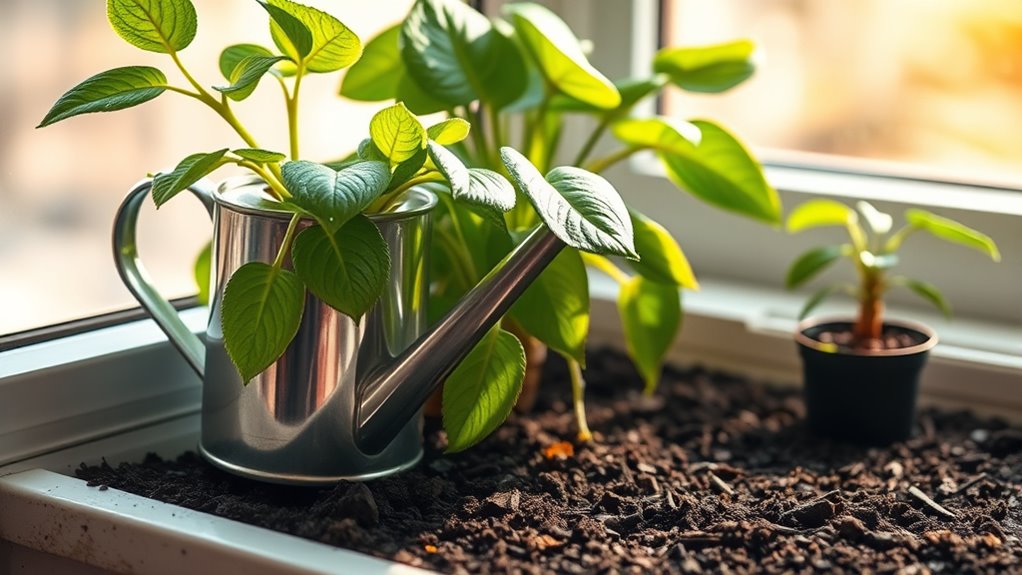
Even if you think you’ve got a handle on watering your indoor plants, common mistakes can easily derail your efforts.
Overwatering is a major pitfall; it leads to root rot and can kill your plants. Conversely, underwatering stunts growth and causes wilting. Identifying the signs of overwatering is essential to preventing further damage to your plants. Additionally, air quality considerations such as humidity can also affect how much water your plants need. For instance, plants like the String of Hearts thrive in well-draining soil that helps maintain appropriate moisture levels. Incorporating nutrient-dense ingredients like chia seeds into your plant care routine can also enhance their health.
Remember to adjust your watering schedule with seasonal changes, as summer often demands more water than winter. Avoid a one-size-fits-all approach; different plants have unique needs.
Always choose pots with drainage holes to prevent waterlogged soil, and check soil moisture before watering.
Lastly, be mindful of environmental factors like light and humidity, as they significantly impact your plants’ water requirements.
Stay observant and adjust your methods accordingly to keep your plants thriving.
Frequently Asked Questions
How Do I Know if My Plant Needs Water?
To know if your plant needs water, check the soil’s appearance; dry soil looks lighter and reflects more light.
Observe your plant for drooping leaves or brown tips, which signal dehydration.
You can also use the finger test—just poke your finger into the soil to feel for moisture.
If the pot feels light when you lift it, that’s another clue it’s time to water.
Regularly inspect your plant’s overall health, too!
Can I Use Ice Cubes for Watering?
Did you know that over 80% of indoor plant owners struggle with watering correctly?
You can use ice cubes for watering, especially for certain plants like orchids. They help prevent overwatering by providing a gradual release of moisture.
Just be cautious; cold water mightn’t suit tropical plants. Three ice cubes weekly can be effective for orchids, but always check your plant’s specific needs to ensure it thrives.
Is Distilled Water Better for Plants?
Yes, distilled water can be better for your plants, especially if they’re sensitive to contaminants.
It’s pure, preventing mineral buildup in the soil, which can harm growth. However, it lacks essential minerals, so you’ll need to supplement with nutrients.
Monitor how your plants respond, and consider mixing distilled water with rainwater or filtered water for a balanced approach.
This way, you’ll ensure they get the best of both worlds.
How Does the Pot’s Drainage Affect Watering?
The pot’s drainage significantly affects your watering routine.
If your pot has good drainage, the soil dries out faster, meaning you’ll need to check moisture levels more often and water more frequently.
On the other hand, pots without drainage can lead to waterlogged soil, requiring you to water less often to prevent root rot.
Always ensure excess water can escape to maintain healthy roots and avoid stressing your plants.
What Time of Day Is Best for Watering?
The best time for watering your plants is in the morning. This way, they can soak up the moisture throughout the day, which helps prevent fungal diseases and pests.
Morning watering also reduces the risk of frost damage, as excess water evaporates before nightfall. Plus, it fits nicely into your daily routine, making plant care more convenient.
Just remember to check the soil moisture to gauge their specific needs!
Conclusion
In the end, watering your indoor plants isn’t just about routine; it’s about understanding their unique needs. Coincidentally, when you align your watering schedule with factors like light, humidity, and plant type, you’ll notice healthier, happier greenery. By avoiding common mistakes and using effective techniques, you’ll not only keep your plants thriving but also enjoy the calming presence they bring to your space. So, pay attention to those cues, and your plants will flourish!

